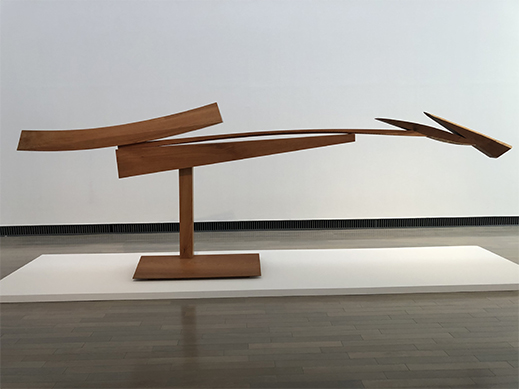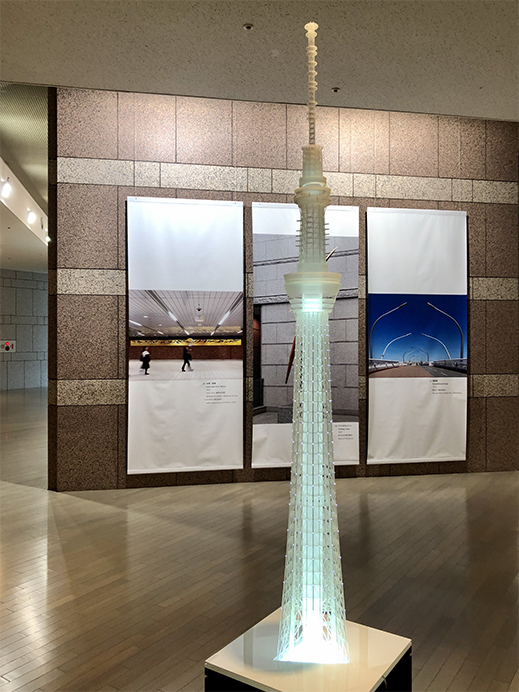 |
Focus features two in-depth reviews each month of fine art, architecture, and design exhibitions at art museums, galleries, and alternative spaces around Japan. |
|
|
 |
 |
 |
Yielding Beauty: A Retrospective for Kiichi Sumikawa
Jennifer Pastore |
 |
Yielding Form (2019), © Kiichi Sumikawa. This recent work in the 45-year-running Yielding Form series is made with wood from zelkova and kalantus trees. |
Every zelkova tree has its own distinct character. Each one has its own direction, and bends and breaks in its own way. So I make use of a bent tree in a way that befits it. Trees have a sense of warmth, flexibility, and intimacy. The life of a breathing tree is a marvelous thing. -- Kiichi Sumikawa
The 88-year-old Kiichi Sumikawa is an artist fully fluent in his materials. His sculptures of wood from Japanese trees (cedars, camphors, zelkovas) are striking works of texture and balance, typically involving abstract forms rising out of sturdy bases. Concave and Convex: A Sumikawa Kiichi Retrospective at Yokohama Museum of Art surveys Sumikawa's six-decade career. Showing works ranging from his sculptures to public projects such as Tokyo Skytree, the exhibition demonstrates how dialogues with materials have shaped his path as a creator.
Sumikawa's creative roots can be traced to a youthful fascination with Kintaikyo bridge in Yamaguchi Prefecture. The structure, dating to 1673, features four stone abutments linking five arched spans. Sumikawa spent time as a high-school student sketching it, and the convex curves of the bridge would become a common motif in his works. He was shocked to see the raw materials of the bridge laid bare when a typhoon demolished it in 1950. He later stated, "The wood and stone blocks that formed the bridge had been transformed into something with an odd and wondrous aesthetic that far exceeded a contemporary art exhibition." This bridge would have a lasting impact on his ideas of beauty and understanding of structure.
 |
|
Model, photograph, and drawings of Kintaikyo bridge. |
In 1952 Sumikawa enrolled at Tokyo University of the Arts, where he studied under Denchu Hirakushi, one of Japan's preeminent wood sculptors, known for his renderings of Buddhist figures. He also learned clay modeling and was commissioned by a university anthropologist to reconstruct ancient human faces. This job led to work for the National Research Institute of Police Science, where he reproduced the faces of crime and accident victims. Although trained in figurative sculpture, Sumikawa's experiences with facial reconstruction would help develop his imaginative abilities and lead him toward a more abstract practice.
Sumikawa established his own studio in the Kiyose neighborhood of western Tokyo in 1961 at the age of 30. He made a bold break with his past at that time, digging a hole in the yard and burying most of the figurative sculptures he had created thus far. He then embarked on a new series, one he called MASK. Its semiabstract wood sculptures feature head- and neck-like protrusions on solid bases. They are inspired by African masks (particularly from the Dogon tribe of Mali), as well as Japanese armor, masks from Japanese ritual dances, and Sumikawa's experiences modeling ancient faces. This series rode the wave of change in postwar sculpture and won acclaim from other artists, including Isamu Noguchi. Sumikawa would continue to focus on MASK through the mid-1970s. About the series, he wrote: "It is my hope that like a Dosojin [traveler's guardian deity] or Hayagriva [a horse-headed Kannon], the MASK series will ultimately function like a guidepost for travelers or an amulet that ensures their safety -- i.e., something that has a spiritual effect on people."
 |
|
MASK (1967, left) and MASK VI (1967, right), © Kiichi Sumikawa. MASK VI, presented at the Shinseisaku Art Exhibition in 1967, was described by art critic Teiichi Hijikata as "an original symbolic form." |
From the mid-1970s, Sumikawa turned to the sculpture series that would last up to the present and in many ways define his aesthetic. The abstract works of Yielding Form are characterized by gently curved wood pieces balanced exquisitely on wood and metal bases. Their arcs embody the concave and convex forms known as sori and mukuri in Japanese. Reminiscent of the arches of Kintaikyo bridge, these forms exist in varying degrees and angles in Sumikawa's work. As noted by the exhibition curators, they evoke traditional elements of Japanese culture: a bowed rice plant, the swoop of a sword, the roof of a temple or shrine. To create the works of Yielding Form, Sumikawa once again drew from the essence of the raw materials he used, explaining that he was "listening to the voice of the wood" to bring out its natural characteristics.
Yielding Form series installation view, Yokohama Museum of Art. |
In addition to their curved shapes, the Yielding Form sculptures are marked by various bumps, scrapings, lines, and rings that reveal differences in wood type and age. Nearly all the works in the Yielding Form series are on display here.
 |
|
Yielding Form (1992), © Kiichi Sumikawa. This sculpture was one of 12 featured in a 1993 exhibition of Sumikawa's work at Takashimaya New York Gallery, his first solo show abroad. |
Yielding Form 97-1 (1997), © Kiichi Sumikawa. |
Sumikawa's most well-known creation is the 634-meter tall broadcasting tower and landmark Tokyo Skytree, for which he served as design director. The structure is located in Tokyo's Sumida Ward, an area that Sumikawa notes has historically suffered natural disasters and is one of the places heaviest hit by the World War II firebombings. Sumikawa says he sees the tower as a sort of requiem monument to the souls lost there.
Tokyo Skytree is just one of more than 100 public projects across Japan that Sumikawa has worked on since the 1980s. His public sculptures, bridges, and installations also demonstrate his commitment to dialogue with materials and to sori/mukuri aesthetics. Take, for instance, the split stone columns of the TO THE SKY sculpture in front of Tokyo Skytree. Its exposed and contrasting textures recall Sumikawa's emphasis on different grains of wood. The curves of the sail-like towers of Kazenoto (Tower of Wind, located on an artificial island in Tokyo Bay) and the bent shape of the light poles of Kamoikehashi Bridge also subtly harken back to the aesthetics of Yielding Form.
 |
|
Model of Tokyo Skytree in front of photographs of Gold and Silver Waves (2004, left) and Kamoikehashi Bridge (1991, right). |
Concave and Convex is both a thorough overview of Sumikawa's long and accomplished career and an excellent showcase of postwar sculpture as seen through the lens of one artist. It also hews closely to Sumikawa's life story, one that has been marked by an ongoing dedication to sculptural practice and engagement with nature and its textures and forms. At the opening for the exhibition, Sumikawa reminded the press crowd that "Japan is a country of trees. I'm afraid we're forgetting that." This exhibition serves as a gorgeous reminder.
Sumikawa is scheduled to give a talk (in Japanese) at Yokohama Museum of Art on 2 May.
All works shown are by Kiichi Sumikawa. All photos are by Jennifer Pastore, by permission of Yokohama Museum of Art. |
 |
 |
Jennifer Pastore
Jennifer Pastore is a Tokyo-based art fan and translator. In addition to Artscape Japan, her words have appeared in ArtAsia Pacific, Sotheby's, and other publications. She is an editor at Tokyo Art Beat. |
|
 |
|